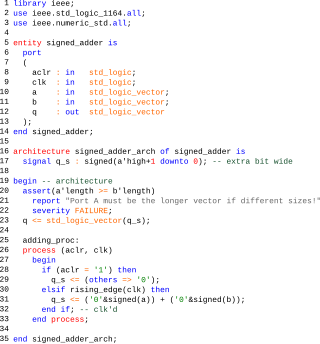| Developer | John Bass |
|---|---|
| First appeared | 2005 |
| Stable release | 1.0.Beta-2 |
| OS | FPGA and related embedded processors |
| License | BSD |
| Website | sourceforge |
| Influenced by | |
| C Programming Language, Streams-C | |
FpgaC is a silicon compiler, which produces digital circuits that will execute compiled language computer programs. The digital circuits produced may use FPGAs or CPLDs as the target processor for reconfigurable computing, or even ASICs for dedicated software applications. Its compiled programming language is a subset of the C programming language.
FpgaC's goal is to be an efficient High Level Language (HLL) for reconfigurable computing on FPGAs or CPLDs, rather than a Hardware Description Language (HDL) for building efficient custom ASICs.
The historical roots of FpgaC are in the Transmogrifier C 3.1 (TMCC) HDL, a 1996 BSD licensed Open source offering from University of Toronto. TMCC is one of the first FPGA C compilers, with work starting in 1994 and presented at IEEE's FCCM95. This predated the evolution from the Handel language to Handel-C work done shortly afterward at Oxford University Computing Laboratory.
TMCC was renamed FpgaC for the initial SourceForge project release, with syntax modifications to start the evolution to ANSI C. Later development has removed all explicit HDL syntax from the language, and increased the subset of C supported. By capitalizing on ANSI C C99 extensions, the same functionality is now available by inference rather than non-standard language extensions. This shift away from non-standard HDL extensions was influenced in part by Streams-C from Los Alamos National Laboratory (now available commercially as Impulse C).
In the years that have followed, compiling ANSI C for execution as FPGA circuits has become a mainstream technology. Commercial FPGA C compilers are available from multiple vendors, and ANSI C based System Level Tools have gone mainstream for system description and simulation languages. FPGA based Reconfigurable Computing offerings from industry leaders like Altera, Silicon Graphics, Seymour Cray's SRC Computers, and Xilinx have capitalized on two decades of government and university reconfigurable computing research.

A field-programmable gate array (FPGA) is a type of integrated circuit that can be programmed or reprogrammed after manufacturing. It consists of an array of programmable logic blocks and interconnects that can be configured to perform various digital functions. FPGAs are commonly used in applications where flexibility, speed, and parallel processing capabilities are required, such as in telecommunications, automotive, aerospace, and industrial sectors.

The VHSIC Hardware Description Language (VHDL) is a hardware description language (HDL) that can model the behavior and structure of digital systems at multiple levels of abstraction, ranging from the system level down to that of logic gates, for design entry, documentation, and verification purposes. Since 1987, VHDL has been standardized by the Institute of Electrical and Electronics Engineers (IEEE) as IEEE Std 1076; the latest version of which is IEEE Std 1076-2019. To model analog and mixed-signal systems, an IEEE-standardized HDL based on VHDL called VHDL-AMS has been developed.
Verilog, standardized as IEEE 1364, is a hardware description language (HDL) used to model electronic systems. It is most commonly used in the design and verification of digital circuits at the register-transfer level of abstraction. It is also used in the verification of analog circuits and mixed-signal circuits, as well as in the design of genetic circuits. In 2009, the Verilog standard was merged into the SystemVerilog standard, creating IEEE Standard 1800-2009. Since then, Verilog is officially part of the SystemVerilog language. The current version is IEEE standard 1800-2017.

A programmable logic device (PLD) is an electronic component used to build reconfigurable digital circuits. Unlike digital logic constructed using discrete logic gates with fixed functions, a PLD has an undefined function at the time of manufacture. Before the PLD can be used in a circuit it must be programmed to implement the desired function. Compared to fixed logic devices, programmable logic devices simplify the design of complex logic and may offer superior performance. Unlike for microprocessors, programming a PLD changes the connections made between the gates in the device.
In computer engineering, a hardware description language (HDL) is a specialized computer language used to describe the structure and behavior of electronic circuits, and most commonly, digital logic circuits.

An application-specific integrated circuit is an integrated circuit (IC) chip customized for a particular use, rather than intended for general-purpose use, such as a chip designed to run in a digital voice recorder or a high-efficiency video codec. Application-specific standard product chips are intermediate between ASICs and industry standard integrated circuits like the 7400 series or the 4000 series. ASIC chips are typically fabricated using metal–oxide–semiconductor (MOS) technology, as MOS integrated circuit chips.
Reconfigurable computing is a computer architecture combining some of the flexibility of software with the high performance of hardware by processing with flexible hardware platforms like field-programmable gate arrays (FPGAs). The principal difference when compared to using ordinary microprocessors is the ability to add custom computational blocks using FPGAs. On the other hand, the main difference from custom hardware, i.e. application-specific integrated circuits (ASICs) is the possibility to adapt the hardware during runtime by "loading" a new circuit on the reconfigurable fabric, thus providing new computational blocks without the need to manufacture and add new chips to the existing system.

A complex programmable logic device (CPLD) is a programmable logic device with complexity between that of PALs and FPGAs, and architectural features of both. The main building block of the CPLD is a macrocell, which contains logic implementing disjunctive normal form expressions and more specialized logic operations.
In computer engineering, logic synthesis is a process by which an abstract specification of desired circuit behavior, typically at register transfer level (RTL), is turned into a design implementation in terms of logic gates, typically by a computer program called a synthesis tool. Common examples of this process include synthesis of designs specified in hardware description languages, including VHDL and Verilog. Some synthesis tools generate bitstreams for programmable logic devices such as PALs or FPGAs, while others target the creation of ASICs. Logic synthesis is one step in circuit design in the electronic design automation, the others are place and route and verification and validation.

Hardware acceleration is the use of computer hardware designed to perform specific functions more efficiently when compared to software running on a general-purpose central processing unit (CPU). Any transformation of data that can be calculated in software running on a generic CPU can also be calculated in custom-made hardware, or in some mix of both.
Handel-C is a high-level hardware description language aimed at low-level hardware and is most commonly used in programming FPGAs. Handel-C is to hardware design what the first high-level programming languages were to programming CPUs. It is a turing-complete rich subset of the C programming language, with an emphasis on parallel computing.
Impulse C is a subset of the C programming language combined with a C-compatible function library supporting parallel programming, in particular for programming of applications targeting FPGA devices. It is developed by Impulse Accelerated Technologies of Kirkland, Washington.
C to HDL tools convert C language or C-like computer code into a hardware description language (HDL) such as VHDL or Verilog. The converted code can then be synthesized and translated into a hardware device such as a field-programmable gate array. Compared to software, equivalent designs in hardware consume less power and execute faster with lower latency, more parallelism and higher throughput. However, system design and functional verification in a hardware description language can be tedious and time-consuming, so systems engineers often write critical modules in HDL and other modules in a high-level language and synthesize these into HDL through C to HDL or high-level synthesis tools.
Flow to HDL tools and methods convert flow-based system design into a hardware description language (HDL) such as VHDL or Verilog. Typically this is a method of creating designs for field-programmable gate array, application-specific integrated circuit prototyping and digital signal processing (DSP) design. Flow-based system design is well-suited to field-programmable gate array design as it is easier to specify the innate parallelism of the architecture.
This is a glossary of terms used in the field of Reconfigurable computing and reconfigurable computing systems, as opposed to the traditional Von Neumann architecture.
High-level synthesis (HLS), sometimes referred to as C synthesis, electronic system-level (ESL) synthesis, algorithmic synthesis, or behavioral synthesis, is an automated design process that takes an abstract behavioral specification of a digital system and finds a register-transfer level structure that realizes the given behavior.

Xilinx ISE is a discontinued software tool from Xilinx for synthesis and analysis of HDL designs, which primarily targets development of embedded firmware for Xilinx FPGA and CPLD integrated circuit (IC) product families. It was succeeded by Xilinx Vivado. Use of the last released edition from October 2013 continues for in-system programming of legacy hardware designs containing older FPGAs and CPLDs otherwise orphaned by the replacement design tool, Vivado Design Suite.
A soft core is a digital circuit that can be wholly implemented using logic synthesis. It can be implemented via different semiconductor devices containing programmable logic, including both high-end and commodity variations. Many soft cores may be implemented in one FPGA. In those multi-core systems, rarely used resources can be shared between all the cores.
Circuit underutilization also chip underutilization, programmable circuit underutilization, gate underutilization, logic block underutilization refers to a physical incomplete utility of semiconductor grade silicon on a standardized mass-produced circuit programmable chip, such as a gate array type ASIC, an FPGA, or a CPLD.
Verilog-to-Routing (VTR) is an open source CAD flow for FPGA devices. VTR's main purpose is to map a given circuit described in Verilog, a Hardware Description Language, on a given FPGA architecture for research and development purposes; the FPGA architecture targeted could be a novel architecture that a researcher wishes to explore, or it could be an existing commercial FPGA whose architecture has been captured in the VTR input format. The VTR project has many contributors, with lead collaborating universities being the University of Toronto, the University of New Brunswick, and the University of California, Berkeley. Additional contributors include Google, The University of Utah, Princeton University, Altera, Intel, Texas Instruments, and MIT Lincoln Lab.